Solar panel technology has dramatically improved over the years and a range of innovative solar panels are now being introduced to the market. There are a lot of things to consider when you’re looking to install a solar panel system one of which is what kind of solar panels to get. Most of the solar panels on the market today for residential solar energy systems can fit into three categories: monocrystalline solar panels, polycrystalline solar panels, and thin-film solar panels. All these types of solar cells are used to harness the sun’s energy. However, each of them causes solar panels to have different characteristics. In this article, we’ll discuss what a monocrystalline solar panel is and how it works. Follow this new blog in Linquip to learn more about this type of solar panel.
The Linquip team aims to provide as much information about solar panels as possible so that you can make an informed decision. Linquip is one of the best sources in the industry for information about monocrystalline solar panels, related equipment, and their installation, use, and maintenance. We at Linquip are always available to help you with any questions or concerns that you may have regarding solar panels or if you need any assistance with them in the future. To begin with, we recommend that you take a look at Linquip’s article entitled “Solar Cells & Panels” before you move on to the next step. This page is intended to be helpful to you in understanding solar panel equipment as a whole.
Being a Linquip Expert is required for you to be able to take advantage of the full potential of the Linquip platform. It can be very beneficial for you to register for an expert account with Linquip since it will enable you to demonstrate your expertise in the area of industrial equipment in a way that is tailored to the industry’s needs. Are you interested in contributing an article to the Linquip website as a guest writer? You can publish your content directly on our website if you choose to use Linquip’s Guest Posting feature.
What is a monocrystalline solar panel?
A monocrystalline solar panel is a solar panel comprising monocrystalline solar cells. The panel derives its name from a cylindrical silicon ingot grown from single-crystal silicon of high purity in the same way as a semiconductor. As the cell is constituted of a single crystal, it provides the electrons more space to move for a better electricity flow. The cylindrical ingot is sliced into wafers forming cells. To maximize the utility of the cells, the circular wafers are wire cut to an octagonal-shaped wafer. These cells have a unique look because of their octagonal shape. They also have a uniform color.
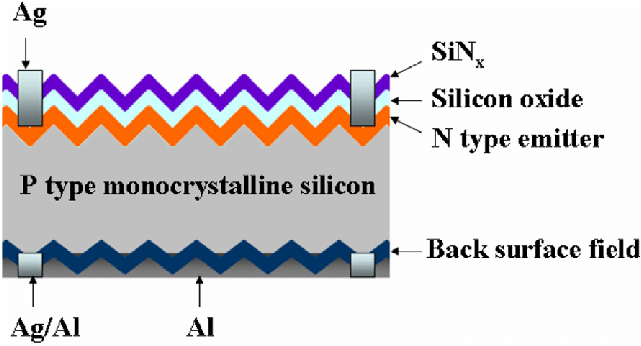
Monocrystalline solar panel construction
As mentioned above, monocrystalline solar panels get their name from how they are made. Each of the individual solar cells contains a silicon wafer that is made of a single crystal of silicon. The single crystal is formed using the Czochralski method, in which a ‘seed’ crystal is placed into a vat of molten pure silicon at a high temperature. The seed is then drawn up and the molten silicon forms around it, creating one crystal. The large crystal also called an ingot, is then sliced into thin wafers that are used to make the solar cells.
Usually, a monocrystalline panel will contain either 60 or 72 solar cells, depending on the size of the panel. Most residential installations use 60-cell monocrystalline silicon panels.
Monocrystalline solar panel working principle
When sunlight falls on the monocrystalline solar panel, the cells absorb the energy, and through a complicated process create an electric field. This electric field comprises voltage and current and generates power which is governed by the equation P (power) = V (voltage) x I (current). This power can be used directly to power devices that run on direct current (DC). This power can also be converted to alternating current (AC) using an inverter.
Monocrystalline solar panel Performance
Monocrystalline solar panels usually have the highest efficiency and power capacity out of all types of solar panels. Monocrystalline panel efficiencies can range from 17% to 20%.
Because monocrystalline solar cells are made out of a single crystal of silicon, electrons can flow easier through the cell, which makes the PV cell efficiency higher than other types of solar panels. The higher efficiency of monocrystalline solar panels means that they require less space to reach a given power capacity. So, monocrystalline solar panels will usually have a higher power output rating than either polycrystalline or thin-film modules.
In other words, you would need fewer monocrystalline solar panels in your solar power system to generate the same amount of power that, say, a greater number of polycrystalline solar panels would. This makes monocrystalline solar panels ideal for people with limited roof space.
Monocrystalline solar panels Features
Monocrystalline solar cells are among the three types of materials that exhibit photovoltaic properties. The other two are polycrystalline solar cells and amorphous or thin-film solar panels. Monocrystalline solar cells’ characteristics are as follows:
- These cells in the panel have a pyramid pattern which offers a larger surface area to collect more energy from the sun’s rays.
- The top surface is diffused with phosphorus which helps to create an orientation that is electrically negative as compared to the bottom which has a positive electrical orientation, which in turn helps to create the electric field.
- To reduce reflection and thereby increase absorption, the cells are coated with silicon nitride.
- The produced electricity is collected through metal conductors printed onto the cells.
Monocrystalline Solar panels Applications
Monocrystalline solar panels have many applications as follows:
- Being more efficient, these panels can produce more electricity for the same area as occupied by panels made of other materials. These panels are quite popular among solar rooftops in urban and rural areas.
- These panels are highly recommended for solar applications on a larger scale, on vast tracts of uncultivable land.
- Smaller panels generating between 5 and 25 Watts of electricity are useful for charging phones, cameras, and laptops.
- Panels generating between 40 and 130 Watts are useful for powering higher-wattage appliances such as refrigerators and microwave ovens.
- These panels are extremely useful in lighting up gardens
- These panels can form an array and are used to power rural homes.
- These panels are perfect for street lighting as stand-alone panels.
For those looking to enhance their understanding of solar panel applications or need assistance with related projects, check out this affordable paper writing help online. Monocrystalline solar panels
Monocrystalline solar panels Cost
Monocrystalline solar panels’ price is higher than other kinds of solar panels because of the way these panels are manufactured. Their high efficiency and power ratings also bump up the price. Most premium solar panels, like the SunPower X-series and the LG NeON panels, are monocrystalline.
According to the Lawrence Berkeley National Laboratory, monocrystalline solar panels sell for about $0.05 per watt higher than polycrystalline modules. As solar technology and manufacturing have improved, the price difference between polycrystalline and monocrystalline panels has shrunk.
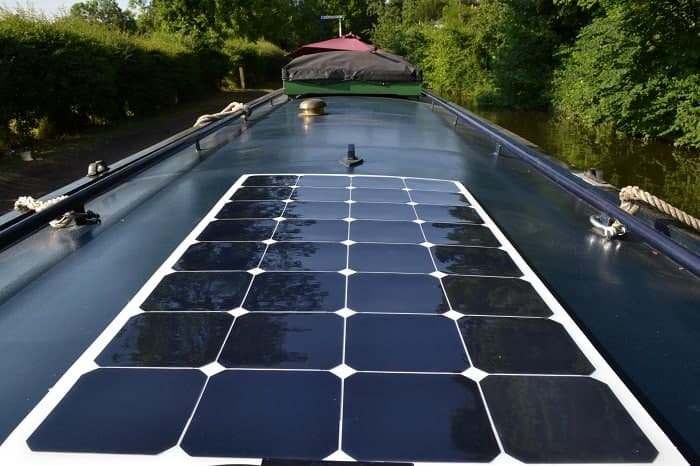
Monocrystalline Solar Panels Advantages and Disadvantages
While they are the most efficient solar cell on the market, several advantages and disadvantages come with monocrystalline solar panels, each of which is listed below.
Here are some of the advantages of monocrystalline solar panels:
- They have the highest level of efficiency at 17-22%.
- They require less space compared to other types due to their high efficiency.
- Manufacturers state that this form of solar cell lasts the longest, with most giving them a 25-year warranty.
- These panels exhibit greater heat resistance.
- They perform better in low levels of sunlight, making them ideal for cloudy areas.
Here are some of the disadvantages of monocrystalline solar panels:
- They are the most expensive solar cells on the market, so not in everyone’s price range.
- The performance levels tend to suffer from an increase in temperature. However, it is a small loss when compared to other forms of solar cells.
- There is a lot of waste material when the silicon is cut during manufacture.
Monocrystalline solar panels vs. polycrystalline solar panels
While both monocrystalline and polycrystalline work on the same principle of capturing solar energy and both will go a long way in reducing your electricity bills, there are a few basic differences between the two. The main difference between monocrystalline and polycrystalline solar cells in Hindi is the type of silicon solar cell they use; monocrystalline solar panels have solar cells made from a single crystal of silicon, while polycrystalline solar panels have solar cells made from many silicon fragments melted together.
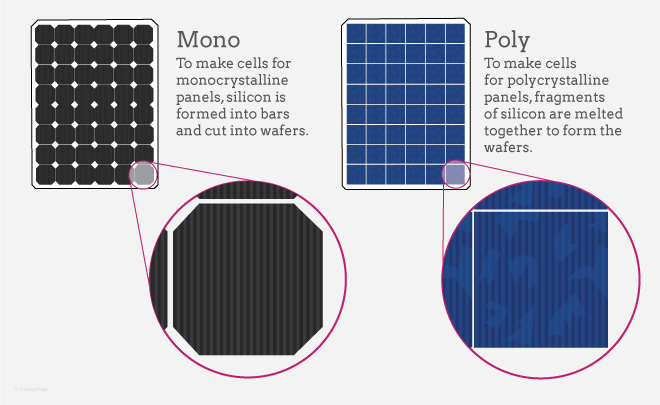
The differences between monocrystalline and polycrystalline solar panels are mentioned in the following chart.
|
Parameters |
Monocrystalline |
Polycrystalline |
| Cost | High | Low |
| Efficiency | High | Low |
| Appearance | Black color panels | Bluish color panels |
| Temperature Coefficient | High | Low |
| Lifespan | Up to 25 years | Up to 25 years |
| Space | Occupies less rooftop space | Takes more space |
| Performance | Performs better even in low light | Low efficiency in cloudy weather |
| Key Manufacturers | SunPower, LG | SolarWorld, Trina |
To choose between the best monocrystalline solar panels and polycrystalline solar panels, you should evaluate them on the following parameters.
- Price: Monocrystalline solar panels for sale will be relatively more costly compared to polycrystalline solar panels. You should draw a careful cost-benefit analysis and determine your budget to make the right choice for you.
- Efficiency: Among the key advantages of monocrystalline solar panels is their high-efficiency rate. These products are made from superior-grade silicone, which has a single-crystal structure. Therefore, electricity flow has minimal resistance in these cells. On the other hand, although one of the advantages of polycrystalline solar panels is their lower price, their efficiency is also lower (between 14 and 16 percent) due to their reduced silicon purity.
- Lifespan: When you compare the initial installation costs between monocrystalline vs. polycrystalline solar panels, you should also look at the average lifespan of each. Monocrystalline solar panel manufacturers will usually offer a 25-year warranty because of the longer lifespan of the product. On this parameter of lifespan, polycrystalline solar panels are not very different, but the warranty period offered by the manufacturers may vary.
- Temperature Coefficient: In warm weather, monocrystalline solar panels can deliver higher efficiency because of their higher temperature coefficient. The output degradation in monocrystalline panels is lower as the temperature rises. If you are living in a region where the summers are longer and warmer, you should carefully consider the temperature coefficient of the solar panels you are choosing.
- Aesthetics: Attractive physical appearance of the solar panels depends on an individual’s sense of aesthetics. But many users find that the speckled blue hue of polycrystalline silicon is not too easy on the eyes. Therefore, they may prefer monocrystalline solar panels as they find them more uniform in appearance, and thus more aesthetically desirable.
- Space: If the available space on your roof is limited but you need more solar output, you may consider monocrystalline solar panels because of their higher efficiency. It is worth paying the additional cost for these panels in your situation because you can maximize your power output even within your space constraints to accommodate a PV system.
So, this is all you need to know about the monocrystalline solar panel. If you enjoy this article, let us know what you think by leaving a reply in the comment section. We will be glad to have your viewpoint on the article. Is there any question we can help you with? Feel free to sign up on Linquip to get the most professional advice from our experts.
Download What is Monocrystalline Solar Panel? PDF
This article is available for download as a PDF file by clicking on the link provided below.
Buy Equipment or Ask for a Service
By using Linquip RFQ Service, you can expect to receive quotations from various suppliers across multiple industries and regions.
Click Here to Request a Quotation From Suppliers and Service Providers
Read More on Linquip
- Efficiency of Solar Panels: A Practical Guide
- A Complete Guide To Solar Panel Output
- Your Handy Guide to Solar Panel Installation Cost
- Do Solar Panels Work at Night?
- Which Type of Solar Panel Is the Best?
- Types of Solar Panels: A Simple Guide Assisting You to Have Better Choice
- Difference Between Solar Energy and Wind Energy
- What is the Difference Between Solar Cells and Solar Panels?
- The 10 Best Solar Generator
- A Concise Introduction to Solar Hybrid Power Systems
- The Complete Guide to Polycrystalline Solar Panel: Features, Working Principles, and Applications
- Is Solar Energy Renewable or Nonrenewable: A Clear Answer
- What Are Solar Farms? All You Need to Know About Solar Parks
- Types of Solar Energy: Learn the Basics, Get the Most Out of It!
- The Ultimate Guide to Solar Panel Calculation: Harness the Power of the Sun with Linquip
- Calculating Solar Panel Wattage: A Comprehensive Guide by Linquip

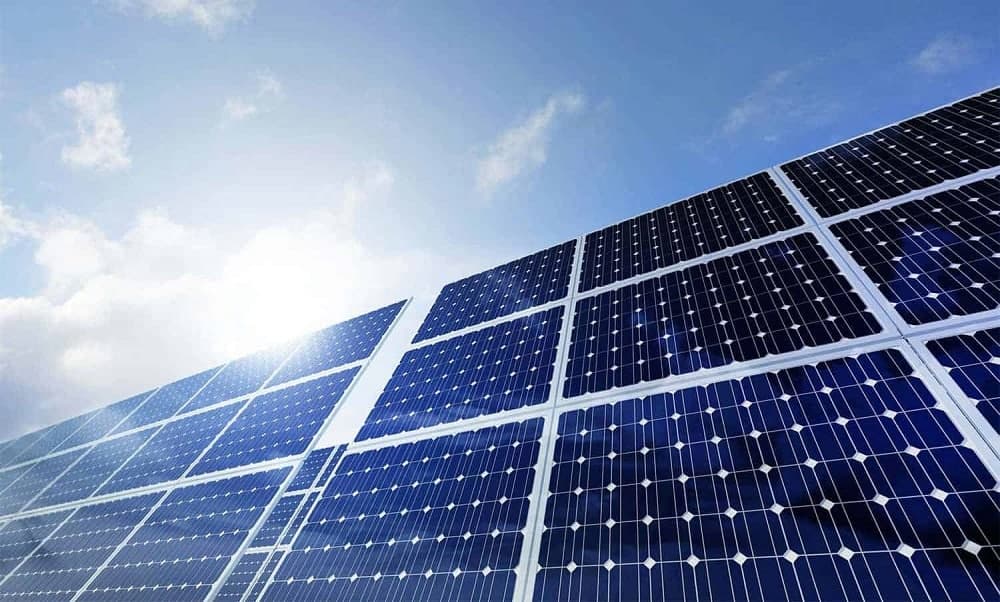
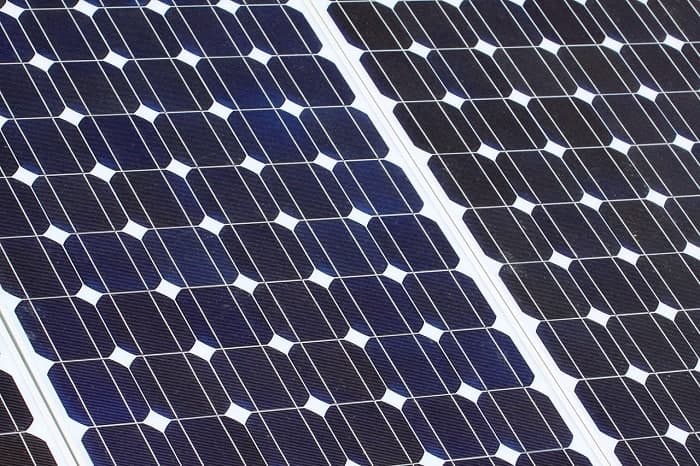


What is a Mono HALF Cell Solar panel
Thanks for visiting our website, Hein! Half-cut cell mono PERC solar modules contain solar cells that are divided in half, which enhances the performance and sturdiness of the solar module. Traditional solar panels with 60 and 72 cells will contain 120 and 144 half-cut cells, respectively.
location pensacola, fl – lot’s of rain – meaning clouds – lot’s of wind – meaning hurricanes –
looking for a total install on my home –
looking for advice – 850 433 1620 -harold
Thank you for this article, I found the explanation of mono v poly crystalline solar panels very useful. I am researching the solar panels as I want to put them on my roof. There is not a lot of simple explanation out there most sites take knowledge of the subject for granted, DW
We’re so happy to hear you had a great experience at Linquip. Your review made our day! Our whole team works very hard to keep our visitors happy, but we can only do it thanks to amazing visitors like you. Thanks again, and we hope to serve you again soon.
Your kind words are much appreciated, Doreen! It was a pleasure having you visit us.
IDEAL DESCRIPTION I EVER SEEN THANKS.
Thanks for visiting our website, Colleen! We also encourage you to visit the Linquip website, where you can find numerous industrial equipment, along with companies and experts.
Great article man, thanks from Turkiye.
Thanks for visiting our website and leaving your comment! We hope to hear from you again in our other posts.
Thanks for sharing your experience with us! You can also visit our industrial directories, where you can find thousands of various industrial equipment based on your application and demand.